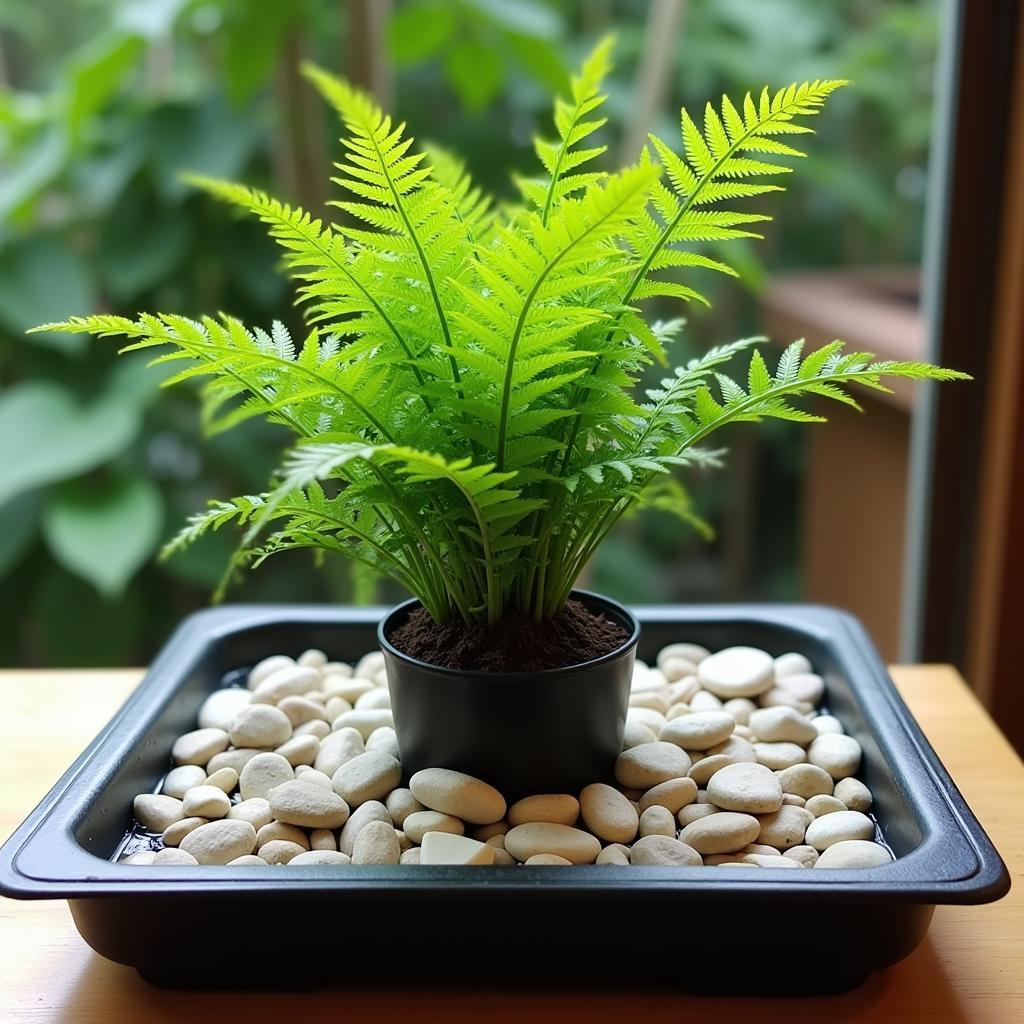Ferns are beloved for their lush, vibrant foliage and their ability to bring a touch of the wild indoors. Proper fern care ensures these beautiful plants thrive, adding a touch of green serenity to your space. This guide will delve into everything you need to know about how to care for ferns, from watering and lighting to troubleshooting common problems. Let’s get started!
Understanding Fern Needs
Ferns hail from diverse habitats, from shady forest floors to tropical rainforests. Understanding their native environment is key to replicating the ideal conditions in your home. Most ferns prefer indirect light, consistently moist soil, and high humidity.
Light Requirements for Ferns
While ferns don’t appreciate direct sunlight, which can scorch their delicate fronds, they do need adequate light to photosynthesize and grow. A north-facing window or a spot filtered by sheer curtains is ideal. You can also supplement with artificial grow lights if necessary. Overly dark conditions will lead to slow growth and a sparse appearance.
Watering Your Ferns
Perhaps the most crucial aspect of fern care is watering. Ferns thrive in consistently moist soil, but they don’t like to sit in water. The key is to water thoroughly when the top inch of soil feels dry. Avoid letting the soil dry out completely, as this can lead to wilting and browning of the fronds. Overwatering, on the other hand, can cause root rot.
If you’re looking for specific advice on a particular type of fern, you might find our guide on boston fern care helpful.
Humidity and Temperature
Ferns appreciate high humidity, mimicking their natural environment. You can increase humidity around your ferns by grouping plants together, placing them on a tray of pebbles filled with water, or using a humidifier. Most ferns prefer temperatures between 65-75°F (18-24°C). Avoid placing them near drafts or heating vents.
 Fern Care: Using a Humidity Tray
Fern Care: Using a Humidity Tray
Choosing the Right Pot and Soil
The right pot and soil are essential for healthy fern growth. A pot with drainage holes is crucial to prevent waterlogging. Choose a pot that’s slightly larger than the fern’s root ball, allowing room for growth. A well-draining potting mix rich in organic matter is ideal. A mixture of peat moss, perlite, and vermiculite provides good aeration and moisture retention.
Repotting Your Fern
Ferns typically need repotting every 1-2 years, or when they become root-bound. Choose a pot slightly larger than the previous one and use fresh potting mix. Gently remove the fern from its old pot, loosen the roots, and place it in the new pot, filling the gaps with fresh soil.
For those interested in a specific type of fern, our guide on foxtail fern care offers detailed information.
Troubleshooting Common Fern Problems
Even with the best care, ferns can sometimes encounter problems. Brown or yellowing fronds can indicate underwatering, overwatering, or low humidity. Pests like spider mites and mealybugs can also infest ferns. Regularly inspect your ferns for signs of pests and treat them promptly if necessary.
Fertilizing Your Fern
Ferns don’t require heavy fertilization. A diluted, balanced liquid fertilizer applied monthly during the growing season (spring and summer) is sufficient. Avoid over-fertilizing, as this can damage the roots.
You can find more general information about various fern species in our guide on fern care. This resource covers a wider range of fern types and their specific needs.
Conclusion
Caring for ferns might seem daunting at first, but with a little understanding of their basic needs, you can successfully cultivate these beautiful plants in your home. By providing adequate light, consistent moisture, and high humidity, you can enjoy the lush, vibrant foliage of your ferns for years to come. Remember to address any problems promptly and adjust your care routine as needed. How to care for ferns effectively comes down to observation and understanding their subtle cues.
FAQ
-
How often should I water my fern?
Water thoroughly when the top inch of soil feels dry. -
What kind of light do ferns need?
Ferns prefer indirect light, avoiding direct sunlight. -
What is the ideal temperature for ferns?
Most ferns thrive in temperatures between 65-75°F (18-24°C). -
How can I increase humidity for my fern?
Use a humidifier, group plants together, or place the fern on a tray of pebbles with water. -
How often should I fertilize my fern?
Apply a diluted, balanced liquid fertilizer monthly during the growing season. -
How do I know if my fern needs repotting?
Repot when the fern becomes root-bound, typically every 1-2 years. -
What are common signs of fern problems?
Brown or yellowing fronds can indicate watering issues or low humidity.
Other Common Fern Care Questions
What are the best types of ferns for beginners?
How do I propagate my fern?
What are the signs of overwatering a fern?
Can I grow ferns outdoors?
For those interested in caring for other fascinating creatures, check out our guide on pacman frog care.
 Thriving Fern in Ideal Conditions
Thriving Fern in Ideal Conditions
When you need assistance, please contact WhatsApp: +1(641)206-8880, Email: [email protected] Or visit: 276 Reock St, City of Orange, NJ 07050, United States. We have a 24/7 customer support team.


